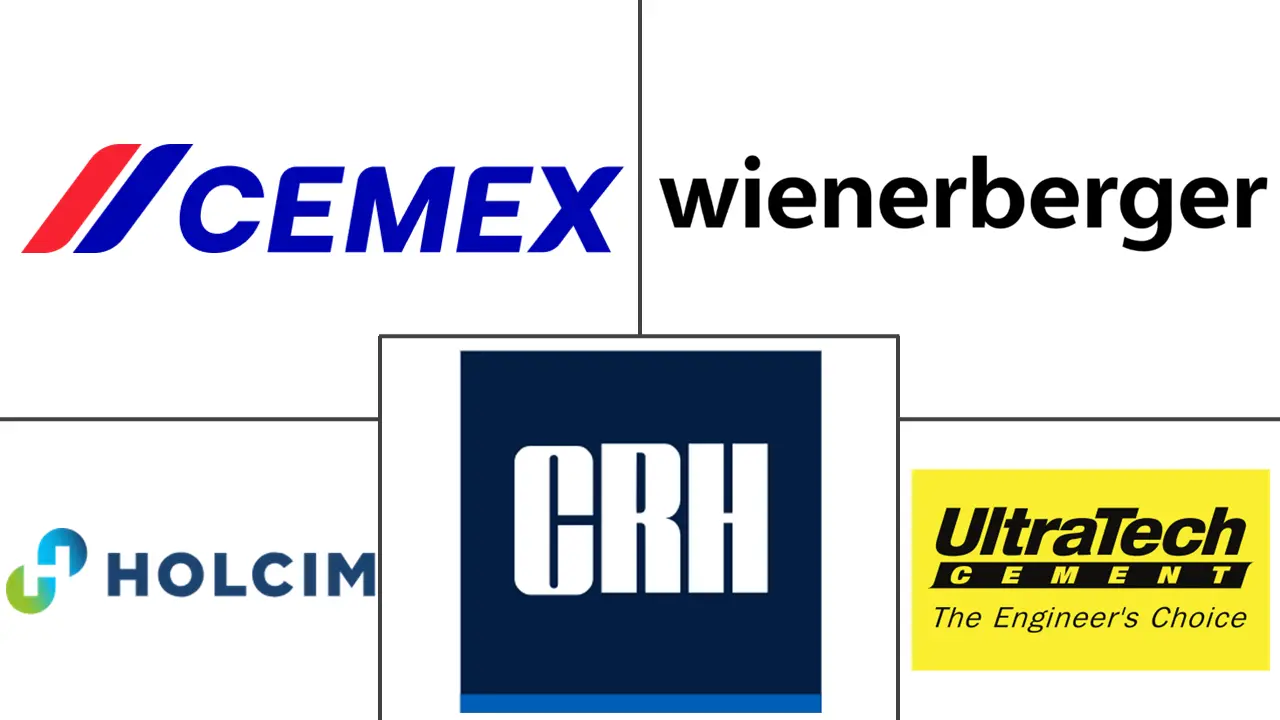Hollow Concrete Block Market Size and Share
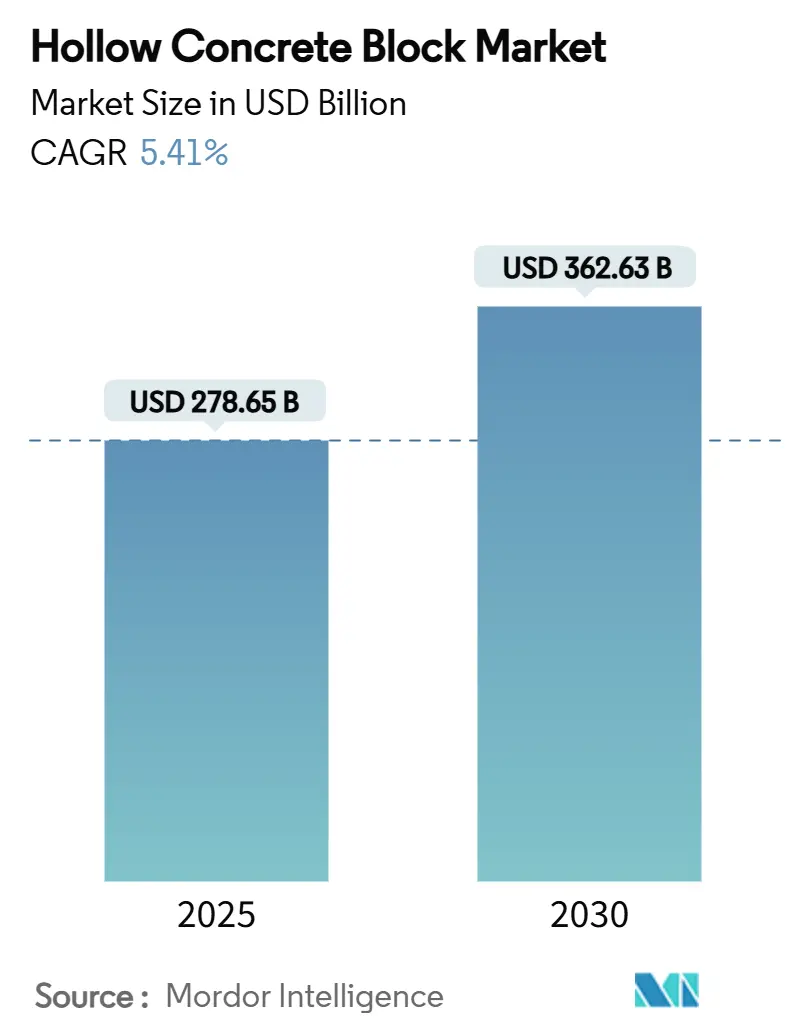
Hollow Concrete Block Market Analysis by Mordor Intelligence
The Hollow Concrete Block Market size is estimated at USD 278.65 billion in 2025, and is expected to reach USD 362.63 billion by 2030, at a CAGR of 5.41% during the forecast period (2025-2030). Urbanization pressures, affordable housing mandates, and infrastructure resilience programs create durable demand, while producers gain pricing power by aligning with green-building credits and modular construction trends. Asia-Pacific leads consumption due to large-scale Indian housing schemes and continued Chinese urban renewal. Split-faced blocks dominate global product adoption for their architectural appeal, yet smooth-faced and specialty formats retain relevance in functional walls and industrial layouts. Competitive momentum centers on vertical integration and low-carbon technologies as major cement groups acquire regional masonry assets and retrofit plants for carbon-capture readiness. Manufacturers able to supply high-volume traditional units and value-added eco-blocks are positioned to outperform.
Key Report Takeaways
- By product type, split-faced blocks held 63.62% of the hollow concrete blocks market share in 2024 and are projected to expand at a 6.44% CAGR through 2030.
- By end-user industry, residential accounted for 47.16% share of the hollow concrete blocks market size in 2024, while other end-user industries are set to advance at a 6.32% CAGR to 2030.
- By geography, Asia-Pacific commanded 46.33% revenue in 2024 and is poised to grow at a 6.18% CAGR toward 2030.
Global Hollow Concrete Block Market Trends and Insights
Drivers Impact Analysis
| Driver | (~) % Impact on CAGR Forecast | Geographic Relevance | Impact Timeline |
|---|---|---|---|
| Rapid urbanisation boosting affordable housing demand | +1.80% | Global, with concentration in Asia-Pacific and Africa | Long term (≥ 4 years) |
| Surge in green-building certifications driving lightweight masonry | +1.20% | North America & EU, expanding to APAC | Medium term (2-4 years) |
| Rising labour costs prompting modular construction adoption | +0.90% | North America & Western Europe | Medium term (2-4 years) |
| Growth of disaster-resilient infrastructure programmes | +0.70% | Global, with priority in hurricane/earthquake zones | Long term (≥ 4 years) |
| Expansion of e-commerce warehouses & logistics hubs | +0.60% | Global, led by North America and Asia-Pacific | Short term (≤ 2 years) |
| Source: Mordor Intelligence | |||
Rapid Urbanization Boosting Affordable Housing Demand
National housing programs continue to set aggressive construction targets that favor concrete blocks for speed and cost efficiency. India’s Pradhan Mantri Awas Yojana has already sanctioned 118.64 lakh urban homes and 321 lakh rural units, with budget approvals for another 2 crore dwellings, sustaining a multi-year pipeline for hollow concrete blocks manufacturers. African governments replicate similar schemes, supported by new local cement plants that shorten supply chains and stabilize price volatility. Although Chinese cement output fell 10% year-on-year in 2024, urban renewal and provincial public-housing quotas preserve baseline block demand. These concurrent programs anchor long-duration growth for the hollow concrete blocks market.
Surge in Green-Building Certifications Driving Lightweight Masonry
Concrete contributes to 25 of 55 LEED v4 credits, allowing hollow units to unlock up to 74 points when combined with recycled content and superior thermal mass[1]National Ready Mixed Concrete Association, “CSR11 - Concrete's Contribution to LEED v4,” nrmca.org . Use of processed lightweight aggregates derived from plastics can secure 8 additional credits while lowering structural weight and transport emissions. European material groups such as Wienerberger target 75% of revenue from net-zero-ready products by 2026 and report renovation resilience despite a sluggish new-build cycle. Premium-priced eco-blocks, therefore, reinforce profitability as green regulations tighten.
Rising Labor Costs Prompting Modular Construction Adoption
Skilled-trade shortages raise labor premiums and elongate schedules in North America and Europe, pushing developers toward factory-built wall panels that integrate hollow concrete blocks. Industry surveys rank masonry among the trades with the greatest recruitment gaps, prompting contractors to automate repetitive tasks and retrain crews. Experimental robotic bricklayers already place 3.75 m² per hour, triple traditional rates, signalling future scalability for block placement. Prefabricated concrete wall studies confirm lower total installed cost once transportation, quality control, and on-site labor savings are netted. Combined, these factors drive modularization, enhancing demand for dimensionally precise blocks manufactured in controlled settings.
Growth of Disaster-Resilient Infrastructure Programmes
FEMA’s Building Resilient Infrastructure and Communities program allocated approximately USD 2.30 billion in FY 2022 to upgrade vulnerable structures, with concrete masonry units endorsed for tsunami, hurricane, and tornado resistance[2]Federal Emergency Management Agency, “Guidelines for Design of Structures for Vertical Evacuation from Tsunamis,” fema.gov . The National Institute of Building Sciences quantifies that USD 1 spent on resilient construction saves USD 11 in recovery costs, supporting municipal mandates for stronger wall assemblies. Post-earthquake housing analyses in Türkiye demonstrate that integrating community facilities with block-built homes compresses per-unit costs while elevating safety outcomes. These policy directions cement hollow block usage in hazard zones.
Restraints Impact Analysis
| Restraint | (~) % Impact on CAGR Forecast | Geographic Relevance | Impact Timeline |
|---|---|---|---|
| Volatility in cement & aggregate prices | -1.10% | Global, with acute impact in import-dependent regions | Short term (≤ 2 years) |
| Stringent carbon-emission regulations on cement industry | -0.80% | EU and North America, expanding globally | Medium term (2-4 years) |
| Skilled-labour shortage for block masonry in developed markets | -0.60% | North America & Western Europe | Medium term (2-4 years) |
| Source: Mordor Intelligence | |||
Volatility in Cement & Aggregate Prices
Global freight disruptions, export levies, and regional carbon fees can widen cement price bands from USD 90–130 per ton to as high as USD 160–240 per ton, squeezing block makers’ margins[3]World Cement Association, “Cement Prices Set to Rise as Tariffs on Imports and Carbon Costs Reshape the Industry,” worldcementassociation.org . Smaller producers located far from quarries or ports face disproportionate input cost swings, triggering capacity rationalization and heightening dependence on integrated cement majors. Consolidation in China, where producer numbers may contract from 300 to 30 by 2030, exemplifies how volatility accelerates market restructuring.
Stringent Carbon-Emission Regulations on Cement Industry
Concrete production contributes 8% of global CO₂ output, leading regulators to demand carbon-capture retrofits and supplementary cementitious material adoption. Studies project Hebei Province emissions could fall 50% by 2035 under enhanced low-carbon scenarios, underscoring required investment and process overhauls. Calcium sulphoaluminate cements provide lower-carbon alternatives but present durability and reinforcement challenges at scale. Producers that secure slag, fly ash, or geopolymer substitutes gain cost and compliance advantages, whereas laggards risk fines and supply-chain exclusion.
Segment Analysis
By Product Type: Architectural Preference Fuels Split-Faced Dominance
Split-faced blocks captured 63.62% of the hollow concrete blocks market in 2024 and will outpace other formats at a 6.44% CAGR to 2030. Their textured exteriors resemble hewn stone yet preserve the dimensional accuracy and load-bearing capacity of conventional concrete masonry units, appealing to architects specifying visually exposed facades. The hollow concrete blocks market size for split-faced units is projected to widen fastest in premium residential and civic projects that blend function with street-level aesthetics. Smooth-faced blocks hold steady demand in industrial and back-of-house walls where painting or parging masks surface finish. Innovations such as Spherical Block LLC’s interlocking arch modules illustrate how geometry advances expand hollow block applications into curved roofs and domes, creating fresh value pools.
Manufacturing trends reinforce this hierarchy. Semi-automated split-face lines adopt abrasive splitting stations followed by robotic palletizing, lifting output volumes while maintaining consistent texture. Plants deploying geopolymer binders report up to 40% lower embodied carbon relative to Portland blends, enhancing their LEED contribution and winning specification in green public tenders. As green-building codes tighten, producers able to certify Environmental Product Declarations across their split-faced range can command price premiums and defend share.
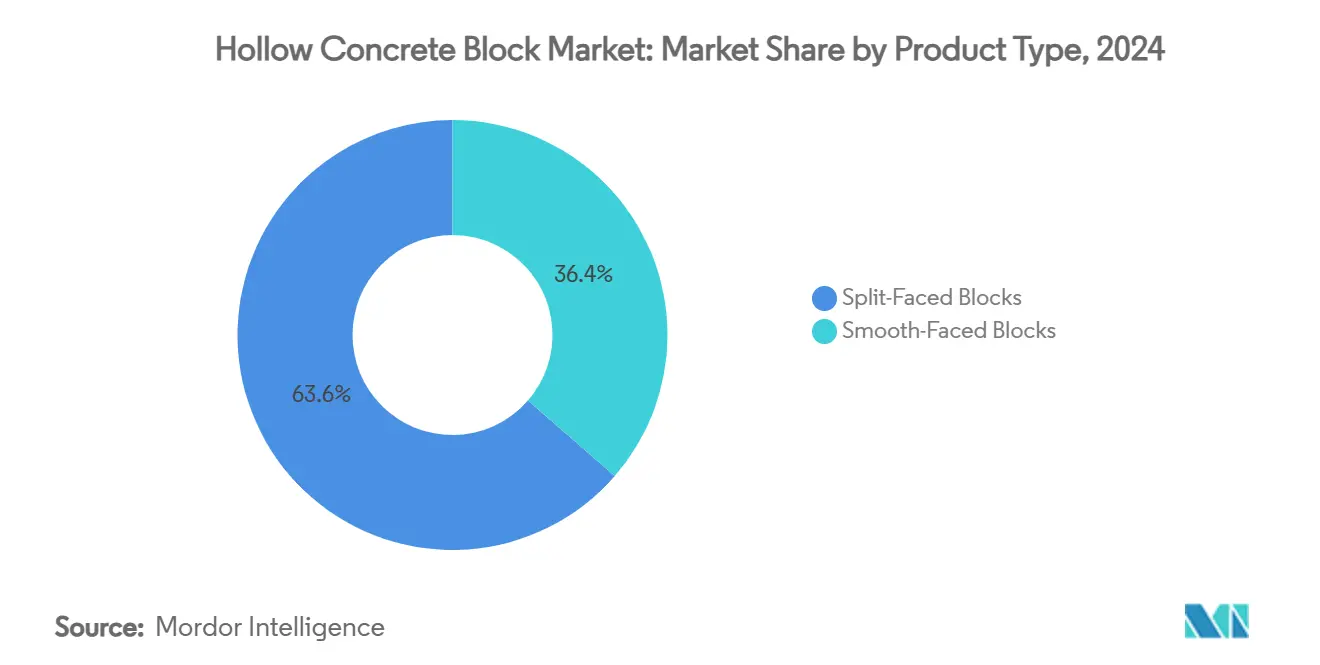
By End-User Industry: Housing Leads, Infrastructure Accelerates
Residential construction generated 47.16% of global revenue in 2024, supported by large-scale public schemes in South and Southeast Asia that mandate hollow blocks for costed disaster resilience. Affordable housing grants in India require local material use, directing procurement toward nearby block yards and reinforcing rural employment. The hollow concrete blocks market size for residential applications will remain anchored by such domestic content rules even as alternative panels emerge. Other end-user industries, including logistics, data centers, and public utilities, form the fastest-growing cohort at 6.32% CAGR through 2030. These sectors value blocks’ fire rating, impact resistance, and thermal mass in high-occupancy or high-heat environments. Infrastructure bills in North America and seismic improvement programs in Japan further scale non-housing demand, while emerging hydrogen and battery plants specify heavy-duty CMU enclosures for blast mitigation.
Growth of the “other” category accelerates supplier diversification strategies. Block makers partner with engineering firms to pre-detail wall systems complete with reinforcing cages and grouted cells to meet rigorous industrial codes. Such turnkey packages shorten project schedules and create switching costs that insulate suppliers from pure price competition.
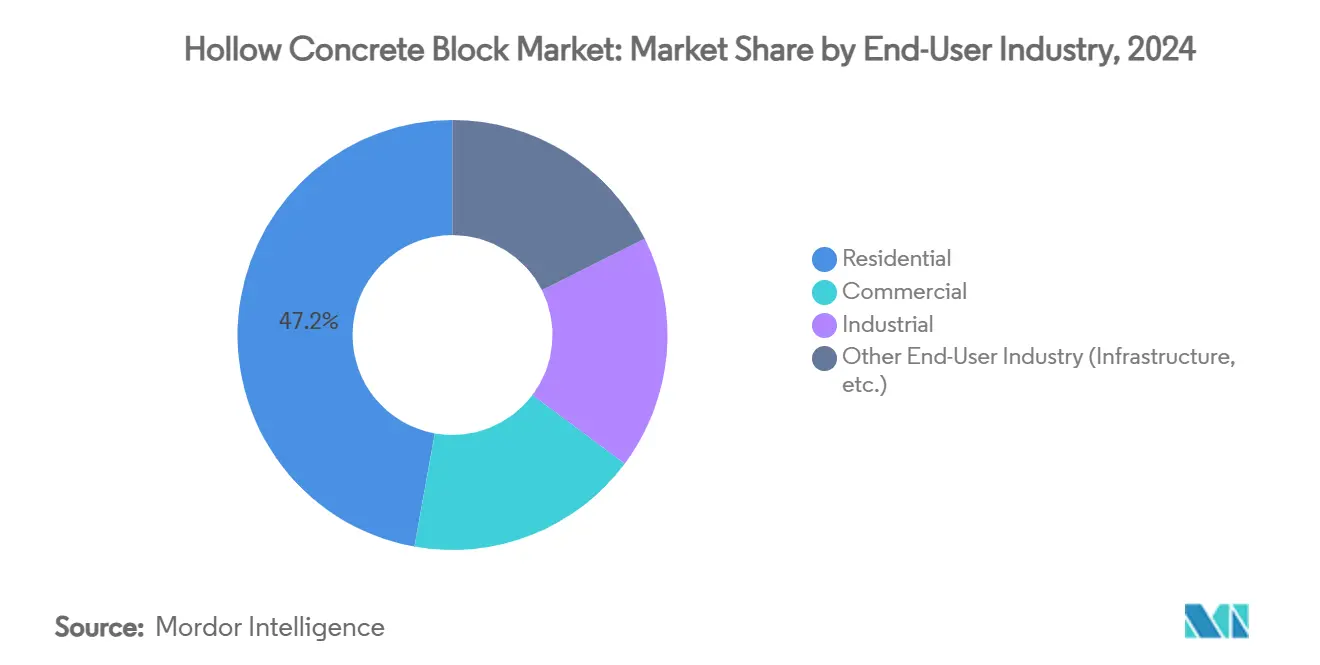
Note: Segment shares of all individual segments available upon report purchase
Geography Analysis
Asia-Pacific retained 46.33% global share in 2024 and is on track for 6.18% CAGR through 2030, buoyed by sovereign housing blueprints, metro expansions, and regional manufacturing relocation. Indian demand alone absorbs vast concrete output, with the government approving an additional 2 crore dwellings that stipulate resilient wall systems built from locally sourced hollow units. Although Chinese cement production dipped by 10% in 2024, ageing urban stock and coastal flood-defence upgrades sustain steady block consumption. Southeast Asian nations welcome electronics and EV assembly plants that require rapid warehouse construction, driving imports of automated block lines from Japan and Germany to meet quality tolerances.
North America benefits from federal infrastructure stimulus and an accelerating shift toward off-site construction. Over 60,000 projects funded under the Infrastructure Investment and Jobs Act expand highways, ports, and broadband corridors, each demanding durable boundary walls and substation enclosures. Hollow concrete blocks market share gains in the region reflect adoption of modular wall panels that integrate insulation and anchor plates, reducing crane picks and labor hours. FEMA’s resilience grants channel additional block demand into coastal rebuilds, while private e-commerce investors specify concrete masonry for distribution centers to meet fire-rating insurance requirements.
Europe faces subdued new-home starts yet demonstrates resilience in renovation and public-works segments. Producers mitigate lower volumes by emphasizing value-added low-carbon units and thermal upgrades in retrofit markets. Wienerberger reports over half of 2024 revenue now stems from renovation and infrastructure, cushioning the impact of weak German housing starts. Eastern EU markets show healthier momentum as EU funds flow into transport corridors and climate-adaptation schemes, with hollow concrete blocks chosen for their robustness and local aggregate compatibility. The region’s stringent carbon-pricing environment accelerates adoption of supplementary cementitious materials, prompting cross-border knowledge transfer on geopolymer mix designs.
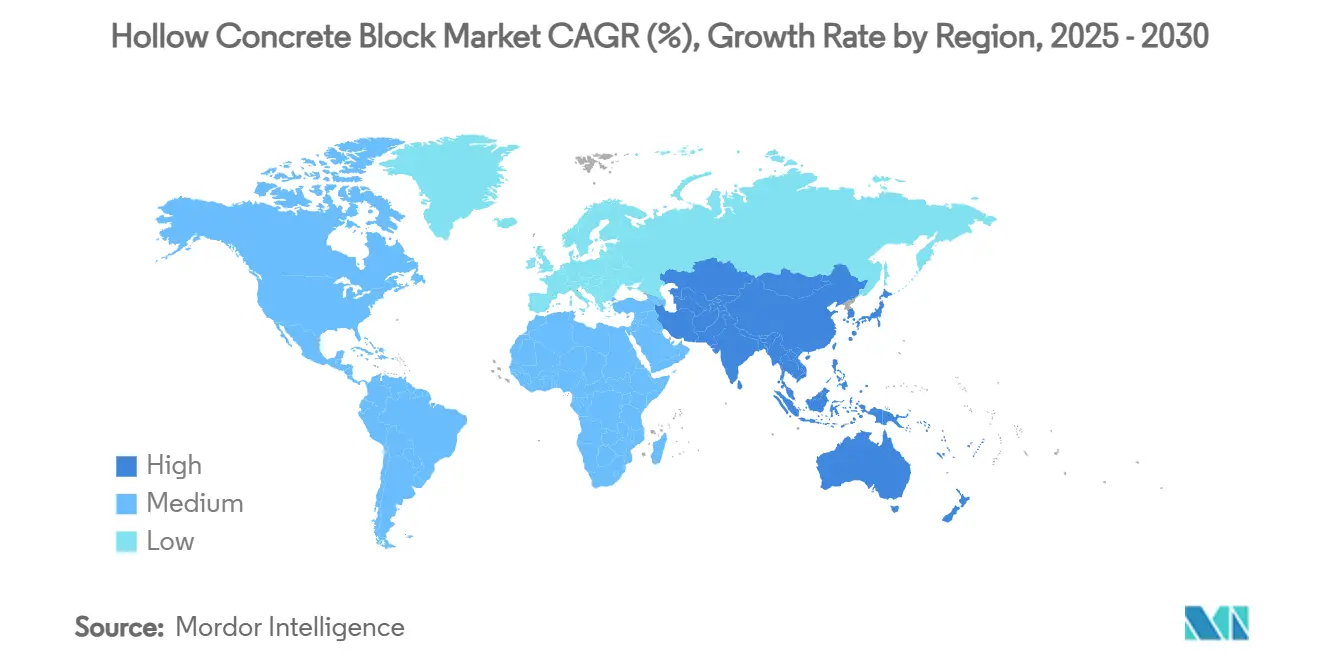
Competitive Landscape
The sector exhibits moderately fragmented concentration. Top global cement groups leverage quarry ownership and downstream distribution to integrate masonry lines, capturing synergies in raw-material flow and logistics. CRH’s USD 2.10 billion Texas acquisition amplified its Southwest masonry footprint, aligning cement mills with block plants to reduce freight costs and stabilize pricing. UltraTech’s capacity expansion to 151.60 million tonnes per annum positions Indian players to defend domestic share against imports while meeting housing-program targets. Heidelberg Materials and Holcim pursue bolt-on aggregate and sand deals across the United States to ensure resilient supply for their concrete block affiliates.
Innovation-driven challengers occupy specialized niches. French start-up MATERRUP commercialized uncalcined clay-based hollow units that cut lifecycle emissions 44%, aligning with EU net-zero procurement thresholds. Adoption of AI-based quality control, automated cubing, and RFID-enabled pallet tracking spreads quickly among mid-tier producers seeking cost parity with vertically integrated giants.
Customer purchasing criteria evolve toward full-lifecycle performance, forcing suppliers to bundle design support, carbon disclosure, and end-of-life recyclability assurances. Firms that meet these layered requirements while maintaining just-in-time delivery stand to consolidate regional contracts as general contractors down-select to fewer strategic partners.
Hollow Concrete Block Industry Leaders
-
CEMEX S.A.B de C.V
-
CRH Americas
-
Holcim
-
UltraTech Cement Ltd.
-
Wienerberger
- *Disclaimer: Major Players sorted in no particular order
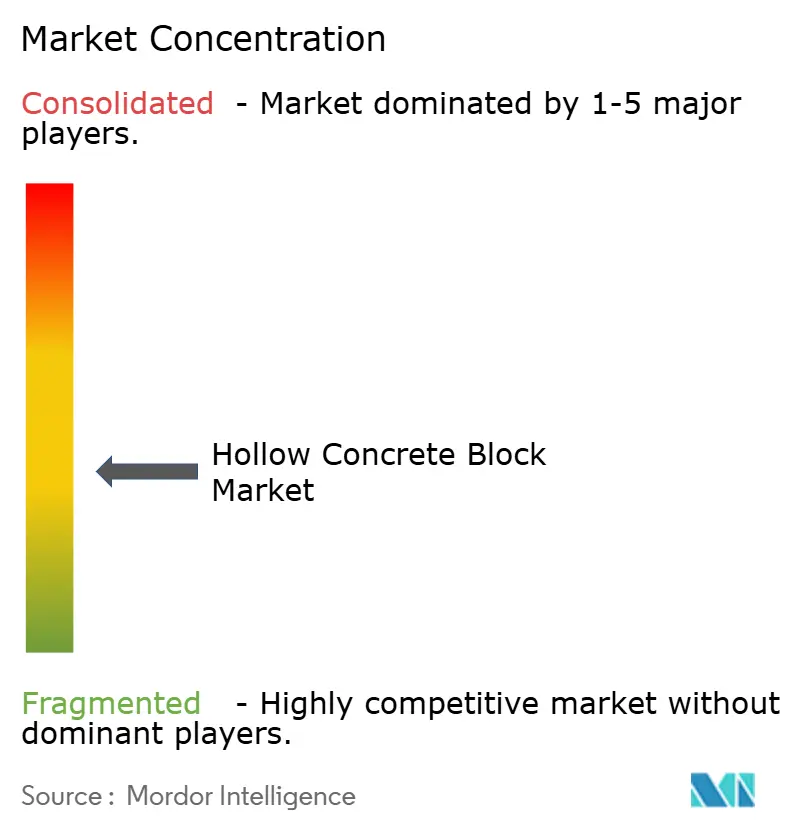
Recent Industry Developments
- September 2024: MATERRUP, a French manufacturer, has developed hollow concrete blocks utilizing uncalcined recycled clay technology. The blocks demonstrate a 44% reduction in carbon emissions compared to traditional concrete blocks while maintaining compatibility with current construction practices.
- August 2024: Oldcastle APG, a subsidiary of CRH Americas, completed the acquisition of Master Block, Inc., expanding its concrete block manufacturing capabilities in the Phoenix metropolitan area to optimize production networks and fulfill growing regional market requirements.
Global Hollow Concrete Block Market Report Scope
A hollow concrete block is a block made of concrete that has hollow spaces between its walls. It is used to build different kinds of walls for different purposes like retaining walls, decorative walls, classic walls, etc. Hollow concrete blocks are made of the same ingredients used in poured concrete walls. The hollow concrete block market is segmented by product type, application, and geography. By product type, the market is segmented into split-faced, and smooth-faced. By application, the market is segmented into residential, commercial, industrial, and other applications. The report also covers the market size and forecasts for the hollow concrete block market in 15 countries across major regions. For each segment, the market sizing and forecasts have been done on the basis of value (USD million).
| Split-Faced Blocks |
| Smooth-Faced Blocks |
| Residential |
| Commercial |
| Industrial |
| Other End-User Industry (Infrastructure, etc.) |
| Asia-Pacific | China |
| Japan | |
| India | |
| South Korea | |
| ASEAN Countries | |
| Rest of Asia-Pacific | |
| North America | United States |
| Canada | |
| Mexico | |
| Europe | Germany |
| United Kingdom | |
| France | |
| Italy | |
| Spain | |
| Russia | |
| NORDIC Countries | |
| Rest of Europe | |
| South America | Brazil |
| Argentina | |
| Rest of South America | |
| Middle East and Africa | Saudi Arabia |
| South Africa | |
| Rest of Middle East and Africa |
| By Product Type | Split-Faced Blocks | |
| Smooth-Faced Blocks | ||
| By End-User Industry | Residential | |
| Commercial | ||
| Industrial | ||
| Other End-User Industry (Infrastructure, etc.) | ||
| By Geography | Asia-Pacific | China |
| Japan | ||
| India | ||
| South Korea | ||
| ASEAN Countries | ||
| Rest of Asia-Pacific | ||
| North America | United States | |
| Canada | ||
| Mexico | ||
| Europe | Germany | |
| United Kingdom | ||
| France | ||
| Italy | ||
| Spain | ||
| Russia | ||
| NORDIC Countries | ||
| Rest of Europe | ||
| South America | Brazil | |
| Argentina | ||
| Rest of South America | ||
| Middle East and Africa | Saudi Arabia | |
| South Africa | ||
| Rest of Middle East and Africa | ||
Key Questions Answered in the Report
What is the current value of the hollow concrete blocks market?
The market is valued at USD 278.65 billion in 2025 and is projected to reach USD 362.63 billion by 2030 at a 5.41% CAGR.
Which region leads the hollow concrete blocks market?
Asia-Pacific holds the largest share at 46.33% in 2024, supported by India’s large-scale housing programs.
Which product category dominates global demand?
Split-faced blocks command 63.62% share and are expected to grow at 6.44% CAGR through 2030.
Why are hollow concrete blocks favored in green-building projects?
They contribute to up to 74 LEED v4 points thanks to thermal mass, recycled content options, and lower embodied carbon mixes.
How are labor shortages influencing block construction?
Rising labor costs push builders toward modular and robotic block-laying solutions that cut installation time and total project expense.
What role does disaster resilience play in market growth?
Government programs like FEMA’s BRIC fund resilient infrastructure, boosting demand for block walls that withstand extreme weather events.
Page last updated on:
